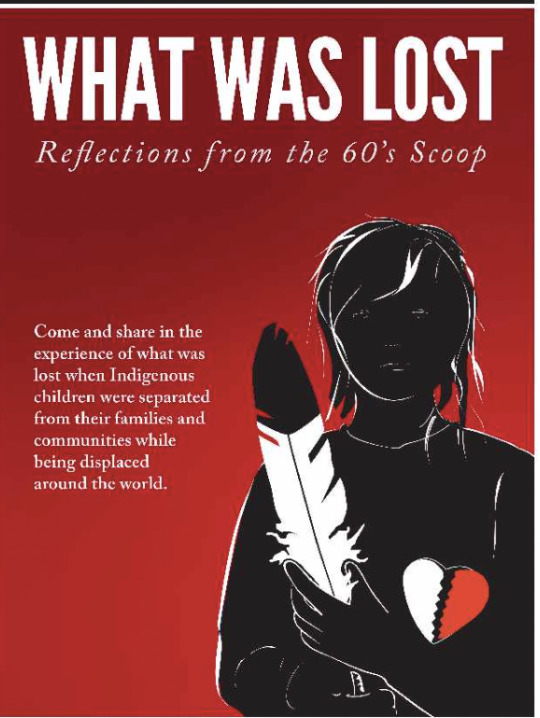#there are more indigenous children in government care than there were during the sixties scoop
Text
How has my understanding of course material evolved over the course?
Before I began this course I did not know a lot about the history of Indigenous peoples outside of residential schools. During week 1 we discussed things like the sixties scoop, the alarming rate of Indigenous children in the foster care system and how easy it is for Indigenous people to lose status if they marry outside their ethnic group.

It was during this week I realized that I still had so much to learn if I was ever going to be able to teach students about Indigenous history and culture as a white educator. During week 2 we examined treaties and the lands we are on. Before this week I knew a little about treaties, the land acknowledgement would talk about the treaty lands we are on and say “we are all treaty people” but I didn’t know when and how treaties were curated. When we examined the document Ontario treaty map I was able to find the treaty land I was on and a little bit about the history of the land. I learned in Oshawa I am on the Williams treaty (Government of Ontario, 2022). This treaty was one of the last surrenders of land in the southern regions of Ontario in 1923. I also realized that in addition to the initial payments and continuing annuity the government did not preserve bands in the reserve lands they possessed. It did not secure hunting and fishing rights for the bands involved (Government of Ontario, 2022). This made me angry but not surprised and encouraged me to want to learn more about the lands I am on.

During week 3 we examined settler colonialism which made me think about all the privileges I have because of this. We also discussed how Canada is trying to reconcile with Indigenous peoples but there is still a long way to go. The TRC (2015) document discusses how reconciliation is about “establishing and maintaining a mutually respectful relationship between [Indigenous peoples and non-Indigenous peoples] in this country. In order for that to happen there has to be awareness of the past acknowledgment of the harm that has been inflicted, atonement of the causes and action to change behavior.” In terms of education, this means ensuring that we as educators are aware of our privileges, continuing to learn about Indigenous culture and sharing with our students Indigenous voices in the curriculum.

In week 5 we talked about Indigenous epistemology of place and land. I didn’t even know what the word epistemology meant until this week but I learned that it is the theory of knowledge. We discussed how Western knowledge especially in education is rooted in colonialism and reorganizing the education system would benefit educators, learners and Indigenous peoples. During week 6 we looked at Indigenous identities, language and cultures where I learned that 25% of First Nations reported knowing an indigenous language (Watson, 2022, p7). This is an alarming statistic considering knowing your native language can “produce better educational, linguistic and self-esteem outcomes for First Nation youth” (Morcom, 2017, p.366). I learned that the education system is very Eurocentric and not built for anything outside of Western knowledge.

In week 7 I learned the difference between cultural appropriation and appreciation and how to produce lessons that would be accepted as appreciation rather than appropriation. During week 8 my peers modeled this concept by giving presentations about an indigenous lesson they found. I found this very beneficial because I was modeled on how to share a lesson that respects Indigenous voices and cultures which is my main question I had at the start of the semester. As one can see, my understanding of course material has evolved dramatically these past few months and I will continue to best educate myself on how to appreciate Indigenous culture and implement it into my teaching pedagogy.
0 notes
Text
Blog 5 for InDP 370 November 2017
The loss of culture, family support, language and home land have been the stark realities of Canadian First Nations since Canada became a Nation in 1867. Now we are celebrating Canada’s 150th birthday, the government of Canada has finally turn their attention to attempting to mend the broken groups of many different aboriginal tribes, and have started the promotion of Reconciliation between the groups and the government.
Prime Minister Justin Trudeau has recently expressed an apology to the First Nations peoples for the damaging atrocities of removing First Nations children from their parent’s home and keeping the children in a school away from the family and forcefully housing them a distance away not easily accessible to their family. Many children died at the hands of the Nuns and Priest that ran the schools. Further penalizing the parents by arresting them if they left the designated land where they were housed in an attempt to see their children. Refer to link http://www.cbc.ca/news/canada/newfoundland-labrador/justin-trudeau-labrador-residential-schools-apology-1.4417443
“Between 1949 and 1979, thousands of Indigenous children were taken from their communities to attend five residential schools that were run by the International Grenfell Association or Moravians. Many said they were sexually and physically abused, and suffered language and cultural losses.”
Recently having listen to a couple of First Nations people generously come to speak in my college class, I learned the practice of assimilation did not cease to stop until the last Religious school was closed in 1996 in Saskatchewan. The 1960’s Scoop, where the First nations child was removed from his families’ home and placed in a :Suitable Caucasian family to promote assimilation” “From the 1960s to the 1980s, thousands of aboriginal children were taken from their homes by child welfare services and placed with non-aboriginal families. Many consider the adoptions as an extension of the residential school system, which aimed to "take the Indian out of the child." Refer to http://www.ctvnews.ca/canada/aboriginals-adopted-into-white-families-during-sixties-scoop-seek-apology-1.1743346
I was embarrassed to learn the removal of children from their families continued until 1980’s. But I didn’t understand why the government agencies felt justified. Upon reading, I learned the removal to have the child adopted was to save in cost “ Provincial governments felt that rather than put money and resources into Indigenous communities to improve issues like child welfare, the most practical and cost-efficient response was to take children from the reserves and place them with non-Indigenous families.” Refer to https://cdnhistorybits.wordpress.com/2016/09/06/what-is-the-60s-scoop/
Hearing these horrible experiences happen in my lifetime, have me questioning the sanity of a leadership reasoning and common sense. I have to believe that the process of reconciliation is an active process. I want these different tribes to heal. As a citizen I can only sympathize and show empathy and promote healing.
In the years of First Nations living on the designated land reserved for the peoples forced to move to, I have learned from the speakers that they were not allowed to move freely from the reservations. They would have to request a “pass” to travel off the reservation to visit a child kept in a Religious run school. The people who had to request a leave, were not able to vote in elections, promote capitalism and start a business to be self-supportive. There were rules imposed on the First Nations people because of century old treaties. The speakers explained that people who immigrated from other countries were able to receive more rights as a new citizen; that were denied the First Nations peoples.
As a nursing student we recognize the Canada Health Act that states the reason the Canadian People have rights to health care in our country. The access to health care is for all citizens to reasonably seek medical treatment. The First nations people who have experienced Religious Schools and the Sixties Scoop are very wary of anyone who will travel on the reservation especially a Caucasian person. In turn, there are no clinics on the reservation, so the access is limited to the citizen on the reservation to be able to leave voluntarily to reach a town or city in reasonable distance. An article written by Brenda Cameron in 2014 expressed the barriers to accessing health care by First Nations people in Manitoba, “According to the 2003 National Aboriginal Health Organization poll,21 18% of First Nations respondents indicated that they had not received needed health care in the past year compared with 12% in the Canadian population. Long waiting times was the primary reason not to access needed care.”. Refer to web site https://cloudfront.ualberta.ca/-/media/nursing/about/docs/understandinginequalities.pdf
Also noted in the additional barriers to health care “As well, while 67% rated positively the quality of health care received, 24% rated their care as worse than that of Canadians. Lack of quality care and inaccessibility were among the main reasons related to participants’ ratings of the care received. Fifteen percent of respondents in the National Aboriginal Health Organization poll reported unfair or inappropriate treatment from a health care provider in the past year, the majority of these being in off reserve settings.”
As future practicing nurse, I need to be responsible to anyone who is walking into a clinic, hospital or traveling clinic who is reaching out and accessing health care. Every situation where a clients’ reason for requesting help is respected and I can act as a positive role model and simply listen and use my skills to treat everyone as an equal.
0 notes